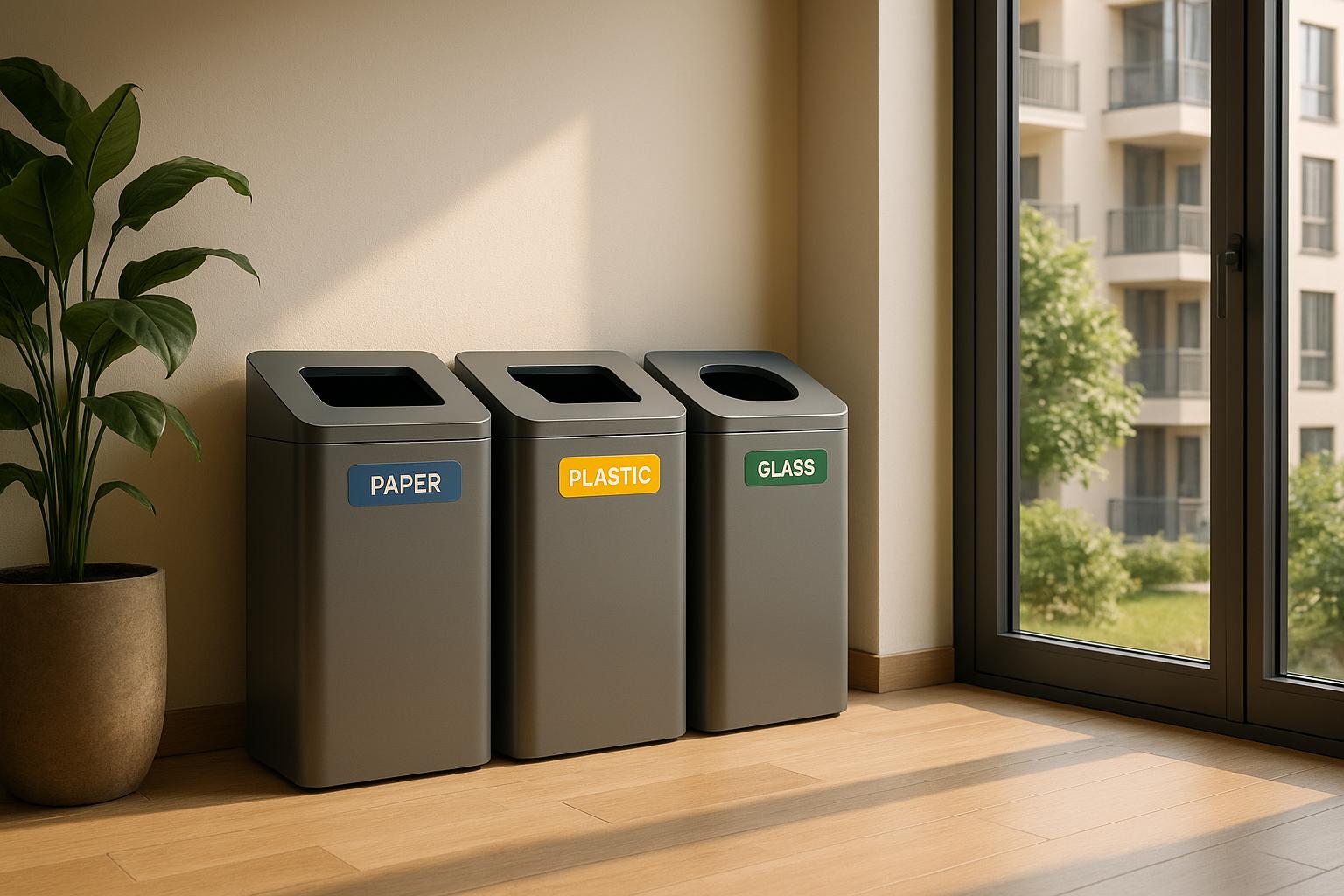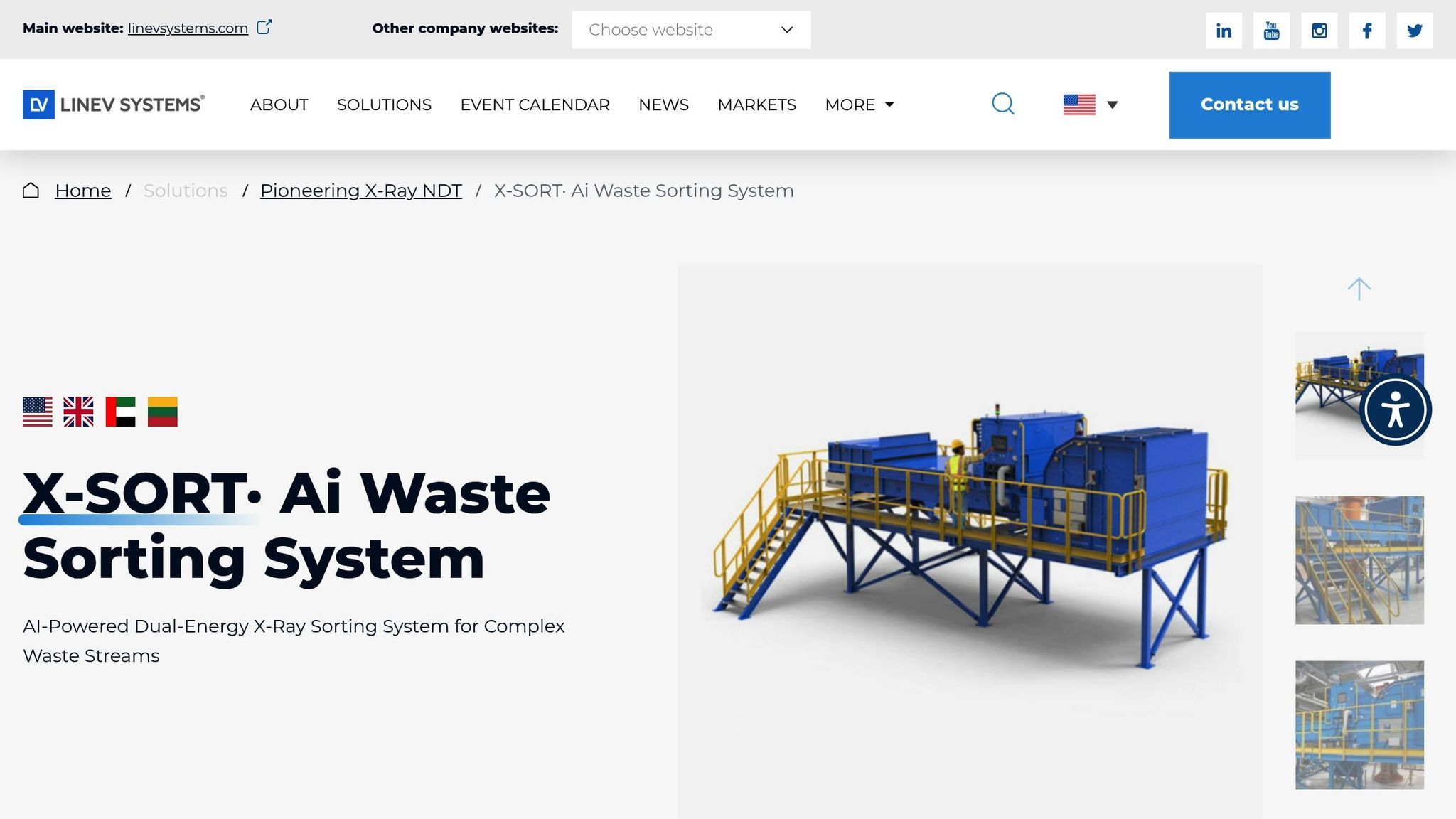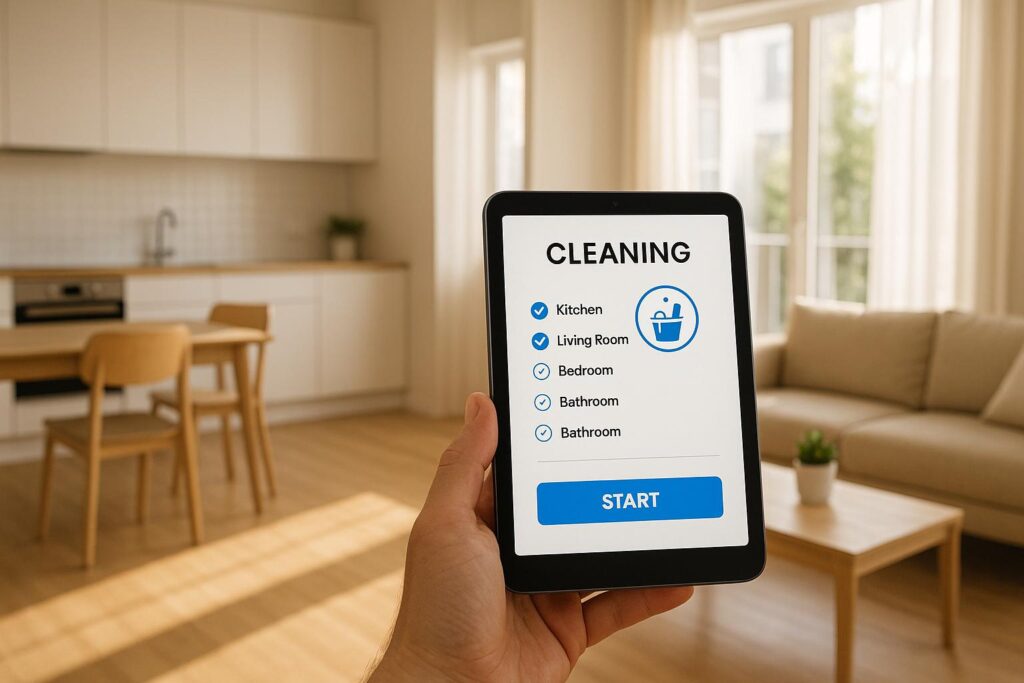Smart waste sorting systems are reshaping waste management in real estate by automating the sorting process and improving efficiency. These systems use AI, sensors, and IoT technology to identify, separate, and manage waste, reducing manual effort and increasing recycling rates. Here’s a quick breakdown:
- Technology: Combines AI for waste identification, IoT-enabled bins for real-time monitoring, and automated collection systems for optimized pickups.
- Benefits: Reduces waste disposal costs, improves recycling, and supports compliance with green building certifications like LEED.
- Challenges: Requires upfront investment and resident education for proper use.
- Impact in Austin: Aligns with the city’s goal of diverting 90% of waste from landfills by 2040.
These systems not only streamline operations but also help properties meet sustainability goals, attract eco-conscious tenants, and reduce long-term costs.
X-SORT | AI-Powered Dual-Energy X-Ray Sorting System for Smart Waste Recovery | LINEV Systems
Core Technologies Behind Smart Waste Sorting
Smart waste sorting systems bring together a network of advanced technologies, creating an efficient and automated approach to waste management. By reducing human error and simplifying the collection process, these systems not only improve waste handling but also open doors for integration into modern real estate developments. Let’s break down the key technologies powering these systems.
IoT-Enabled Smart Bins
At the heart of intelligent waste management are IoT-enabled smart bins. These bins are equipped with a range of sensors – ultrasonic, weight, and temperature – that monitor fill levels, detect irregularities, and flag potential hazards. Many of these bins also include cameras to track contamination, helping property managers identify when residents might need more guidance on proper waste disposal practices.
The data collected by these sensors is crucial for refining maintenance schedules and improving operational efficiency. Low-power communication networks are often used to extend battery life and ensure uninterrupted data transmission. Together, these smart features provide the real-time insights needed to support automated waste collection systems.
AI-Driven Sorting Mechanisms
AI plays a pivotal role in modern waste sorting. Using computer vision and machine learning, these systems can accurately identify and classify waste materials. Multispectral imaging enhances this process by distinguishing between materials that may look similar but have different compositions – an essential feature for effective recycling.
Neural networks analyze visual data by comparing waste items against large material databases, factoring in attributes like shape, size, color, and texture. Machine learning allows the system to continuously improve, adapting to new materials and evolving waste streams based on feedback from human operators. Some systems even use near-infrared spectroscopy to further refine material identification. This level of precision ensures that waste is sorted correctly, laying the groundwork for efficient automated collection.
Automated Collection Systems
Automated collection systems work hand-in-hand with smart sorting technologies to replace traditional waste collection methods. For properties with underground infrastructure, pneumatic tube networks transport sorted waste to central processing facilities via vacuum systems, reducing noise and eliminating traffic disruptions. In other setups, battery-powered AGVs (automated guided vehicles) empty smart bins along routes optimized by real-time fill data.
For locations without underground systems, smart compactors compress waste when bins reach optimal capacity, maximizing storage space and reducing the need for frequent collections. GPS tracking and route optimization software further enhance efficiency by dynamically adjusting schedules based on real-time factors like traffic and weather conditions. When combined with IoT sensors and AI sorting, these automated systems deliver a seamless and integrated waste management solution, ready to be implemented in real estate projects.
How Smart Waste Sorting Works in Real Estate Developments
Smart waste sorting in real estate developments operates through a three-stage process, blending technology and efficiency to manage waste effectively.
Waste Deposit and Initial Sorting
Residents begin by depositing their waste at designated smart collection points equipped with sensors. These sensors, powered by AI, identify recyclable materials. In some properties, pneumatic networks transport waste underground to central collection points. In others, waste is sorted into specific compartments within smart compactors. These compactors compress the waste once a compartment nears capacity, ensuring efficient space utilization. Meanwhile, the system collects data on waste patterns to guide operational improvements.
Data Transmission and Monitoring
After the initial sorting, data from each deposit is sent to facility managers. Smart bins provide real-time updates on fill levels, contamination rates, and usage trends via low-power communication networks. This information is displayed on a dashboard, enabling managers to monitor performance, adjust bin placements, and educate residents about proper sorting practices. This step is essential for managing waste effectively across large properties. Additionally, data analytics reveal peak usage times, allowing managers to optimize collection schedules and system capacity.
Optimized Collection Processes
With the help of real-time data, automated collection systems take efficiency to the next level. These systems determine the best routes and timings for waste collection, ensuring resources are used effectively. For properties with pneumatic networks, waste is directed to central facilities on demand, preventing overflow. A great example is Envac‘s automated waste collection systems, which have been installed in over 1,200 locations worldwide. Their optical sorting technology can slash transport and collection costs by at least 50% compared to traditional methods. This streamlined approach not only cuts operational costs but also reduces carbon emissions by limiting unnecessary vehicle use.
Adding Smart Waste Sorting to Real Estate Projects
Incorporating smart waste sorting systems into real estate projects requires thoughtful planning across infrastructure, regulations, and resident involvement. Developers who take a structured approach can create properties that not only reduce waste but also improve operational efficiency.
Infrastructure and Design Requirements
Smart waste sorting systems need a solid infrastructure foundation. First, ensure a reliable power supply. These systems – whether they include smart bins, sensors, or compactors – depend on consistent electricity. Standard U.S. power supplies are typically sufficient, but backup power systems are essential to avoid interruptions.
Connectivity is another key element. Smart systems rely on real-time data transmission, which can be supported by Wi‑Fi, cellular networks, or dedicated IoT connections. For smaller developments, existing Wi‑Fi networks might suffice, but larger complexes often need dedicated networks to ensure seamless coverage across all waste collection points.
Physical space planning is also crucial. Pneumatic systems require underground infrastructure, while large compactors need reinforced concrete surfaces. Accessibility is equally important – ensure all collection points meet ADA standards to accommodate all users.
Once infrastructure is in place, developers can tap into regulatory and financial benefits.
Regulatory and Sustainability Incentives
Smart waste systems can unlock a range of financial perks, especially through green building certifications and sustainability programs. For instance, certifications like LEED reward projects that improve waste management under categories like Materials and Resources or Innovation, boosting the overall value and appeal of the property.
Local governments are increasingly supportive of advanced waste solutions. Many municipalities offer benefits like expedited permitting, property tax reductions, or lower waste collection fees for projects that demonstrate effective waste diversion. Additionally, utility companies may provide rebates for energy-efficient waste systems, depending on their performance.
Projects that achieve measurable waste reduction can also explore carbon offset markets. By participating in carbon credit programs, properties can generate additional revenue streams. To qualify for these opportunities, it’s critical to maintain detailed waste and efficiency data.
Resident Education and Engagement
The success of smart waste systems doesn’t just depend on technology – it also relies on resident participation. Hosting hands-on demonstrations can help residents understand how to use the system correctly, including which compartments to use for different types of waste.
Mobile apps and gamification can encourage recycling habits by making the process engaging and rewarding. Clear, visual signage at collection points can provide real-time updates on fill levels, sorting instructions, and contamination alerts. Regular communication through newsletters, community websites, or meetings can keep residents informed and motivated to support waste reduction efforts.
To ensure inclusivity, provide multilingual support on all signage and digital platforms. This makes the system accessible to all residents, regardless of language barriers, fostering a sense of community involvement.
For developers in Austin, local resources like Austin Local Team (https://localteam.ai) can provide valuable guidance. Their expertise in regional real estate trends and sustainable design can help navigate local regulations and streamline the integration of smart waste systems.
sbb-itb-4c99469
Benefits and Challenges of Smart Waste Sorting
After exploring system integration, let’s dive into the benefits and challenges of smart waste sorting. These systems offer a range of advantages, from guiding proper waste disposal to reducing contamination. The result? Better recycling efficiency, higher waste diversion rates, and compliance with regulatory standards – all of which can enhance a property’s appeal in the market.
Advantages of Smart Waste Sorting
Smart waste sorting systems bring multiple benefits. They streamline recycling processes, boost waste diversion rates, and help properties stay ahead of shifting regulations. On top of that, they enhance a property’s standing in an increasingly eco-conscious real estate market. These systems not only support environmental goals but also make properties more attractive to tenants and buyers who value sustainability.
Challenges in Implementation
Introducing smart waste sorting systems isn’t without hurdles. For older properties, the need for upfront investment and infrastructure upgrades can be a significant barrier. Additionally, ensuring that these systems function reliably and encouraging residents to adopt new waste management practices are critical challenges developers must tackle. While these obstacles can make implementation complex, they underscore the importance of these systems in achieving local sustainability targets.
Alignment with Austin’s Sustainability Goals
Smart waste sorting aligns perfectly with Austin’s ambitious goal of diverting 90% of waste from landfills by 2040. The city’s Austin Resource Recovery Master Plan actively promotes the use of advanced waste management technologies in new developments, fostering an environment that prioritizes innovation and sustainability. By adopting these systems, properties can actively contribute to Austin’s environmental goals while staying prepared for future regulatory changes. This makes smart waste sorting not just a technological upgrade but also a strategic investment in sustainable real estate.
For developers navigating Austin’s competitive real estate landscape, teaming up with local experts like Austin Local Team (https://localteam.ai) can provide valuable guidance on market trends and the integration of smart waste sorting technologies.
Conclusion
Smart waste sorting systems provide a valuable advantage for real estate developers aiming to thrive in Austin’s competitive market. These cutting-edge solutions not only make waste management more efficient but also help properties meet environmental targets and cater to the rising demand for eco-friendly living.
By incorporating IoT-enabled bins, AI-driven sorting, and automated collection systems, waste management becomes seamless – from the moment waste is deposited to its optimized collection. This integrated approach helps reduce contamination, improve recycling rates, and generate actionable data to refine operations further.
With Austin experiencing a 20% population surge and its ambitious goal of achieving zero waste by 2040, traditional waste management methods are falling behind. Smart systems address these challenges head-on, enabling properties to handle increasing waste volumes, comply with stricter regulations, and appeal to environmentally conscious residents.
While initial investments in infrastructure and educating residents may present hurdles, the long-term rewards make them worthwhile. Adopting smart waste sorting systems today positions properties as forward-thinking leaders in sustainability and modern innovation.
FAQs
How can smart waste sorting systems be integrated into real estate, and what should developers keep in mind?
Integrating Smart Waste Sorting Systems in Real Estate
Smart waste sorting systems can fit right into real estate projects by leveraging technologies like underground vacuum collection and IoT-enabled smart bins. These setups connect to centralized platforms, allowing for automated waste collection and real-time monitoring. However, implementing these systems often requires developers to upgrade infrastructure, such as adding underground piping, network connectivity, and sensor-based systems.
When planning, developers should focus on a few key factors. First, ensure the system is compatible with existing building infrastructure. It’s also important to designate enough space and power for the equipment and select solutions that can adapt to future technological advancements. Using AI and machine learning can boost sorting accuracy and efficiency, but careful attention must be paid to data security and system management during the design phase.
Why is educating residents important for smart waste sorting systems, and how can communities boost participation?
Educating residents plays a key role in making smart waste sorting systems work. It equips people with the knowledge they need to dispose of waste correctly, recycle more effectively, and understand the positive environmental impact of their actions. When residents are well-informed, they are more likely to follow the system accurately and stick with it, which helps everything run smoothly and efficiently.
Communities can encourage participation by organizing interactive workshops, launching awareness campaigns, or even offering rewards for proper sorting habits. Providing clear instructions and user-friendly tools can also make it easier for residents to embrace the system and stay committed over time.
How can smart waste sorting systems benefit real estate properties financially and environmentally?
Smart waste sorting systems bring financial and environmental benefits to real estate properties. On the financial side, these systems can lower waste collection costs – by up to 30% – through smarter scheduling and routing. By reducing the number of pickups and maintenance needs, properties can streamline operations and save money.
From an environmental perspective, fewer waste collection trips mean lower emissions, which can improve air quality. These systems also boost recycling rates by sorting waste more efficiently, aligning with sustainability goals and promoting greener communities. For real estate projects, this blend of cost efficiency and environmental responsibility makes smart waste sorting a smart long-term choice.






